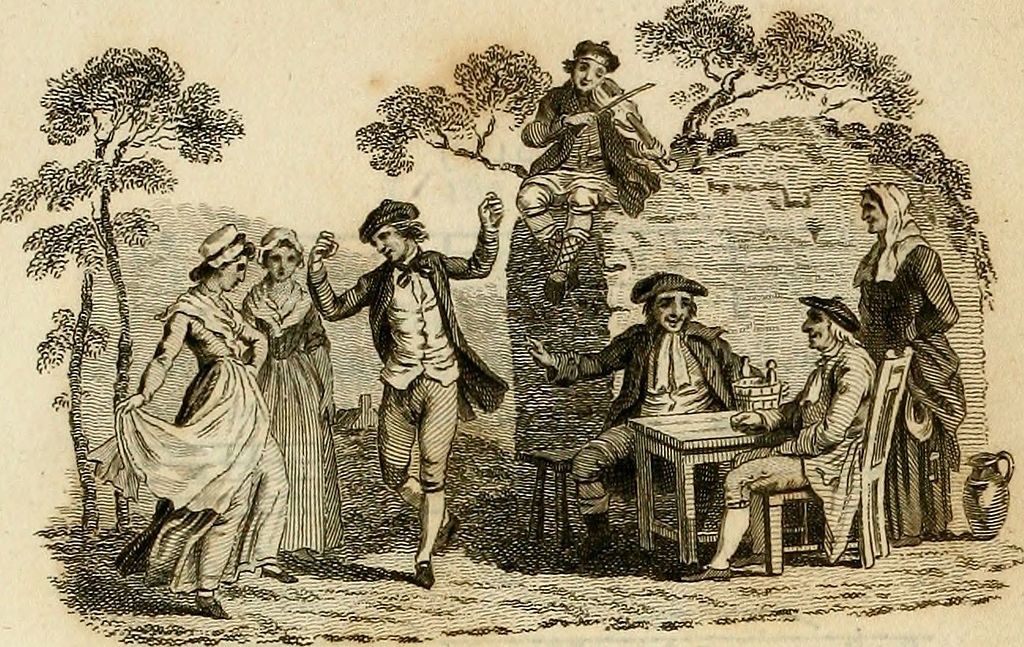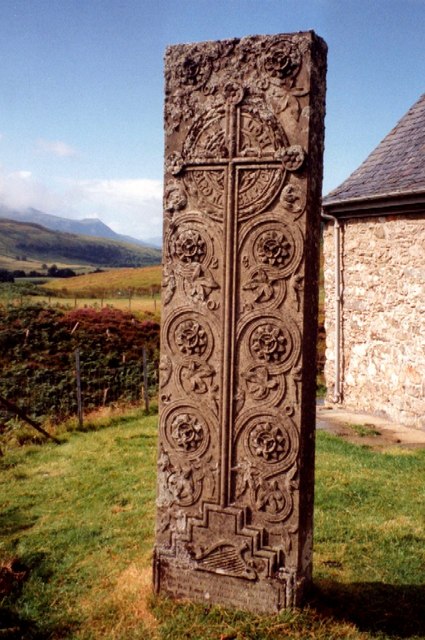This is the second post about music and dance in Scotland. Here, we look at some examples of Scottish songs, as well as eminent musicians, especially musical families, and people with a love of music.
Scottish songs
In the Statistical Accounts you can discover lyrics and references to particular Scottish songs. Actual people, events and settings are within their narrative, making them distinctly Scottish. Scenes of Scottish songs include the farm of Cowden Knows, about a mile outside of Banff, “justly celebrated for its rural beauty” and supposedly “the scene of the plaintive Scots ballad” The New way of the Broom of Cowden Knows (OSA, Vol. XX, 1798, p. 328), as well as the Yarrow Water in Yarrow, County of Selkirk, which is the location of many songs, including The Sang of the Outlaw Murray, The Dowie Dens of Yarrow (also known as The Braes of Yarrow) and Yarrow Vale. (NSA, Vol. III, 1845, p. 37)
People are also the subject of songs. One example is The Lass of Patie’s Mill who resided in the parish of Keithhall, County of Aberdeen. “Her father was proprietor of Patie’s mill, in Keithhall; of Tullikearie, in Fintray; and Standing Stones, in the parish of Dyce. From her beauty, or fortune, or from both causes, she had many admirers; and she was an only child. One Sangster, laird of Boddom, in New Machar parish, wished to carry her off, but was discovered by his dog, and very roughly handled by her father, who was called black John Anderson. In revenge, he wrote an ill-natured song, of which her great grandson remembers these words:
Ye’ll tell the gowk that gets her,
He gets but my auld sheen.
She was twice married; first, to a namesake of her own, who came from the south country, and is said to have composed the Song, to her praise, that is so generally admired, and partakes much of the music, which, at that time, abounded between the Tay and the Tweed.” (OSA, Vol. II, 1792, p. 542)
You can hear a recording of the song The Lass o Patie’s Mill on Tobar an Dualchais.
Another example is the song Fair Helen. “She was a daughter of the family of Kirkconnell, and fell a victim to the jealousy of a lover. Being courted by two young gentlemen at the same time, the one of whom thinking himself slighted, vowed to sacrifice the other to his resentment, when he again discovered him in her company. An opportunity soon presented itself, when the faithful pair, walking along the romantic banks of the Kirtle, were discovered from the opposite banks by the assassin. Helen perceiving him lurking among the bushes, and dreading the fatal resolution, rushed to her lover’s bosom, to rescue him from the danger; and thus receiving the wound intended for another, sunk and expired in her favorite’s arms. He immediately revenged her death, and flew the murderer. The inconsolable Adam Fleeming, now sinking under the pressure of grief, went abroad and served the banners of Spain, against the infidels. The impression, however, was too strong to be obliterated. The image of woe attended him thither; and the pleasing remembrance of the tender scenes that were past, with the melancholy reflection, that they could never return, harassed his soul, and deprived his mind of repose. He soon returned, and stretching himself on her grave, expired, and was buried by her side.” He was said to have written the song whilst he was in Spain. The lyrics can be found in the parish report of Kirkpatrick-Fleming, County of Dumfries (OSA, Vol. XIII, 1794, p. 274) There is also a recording of the song Fair Helen of Kirkconnel on Tobar an Dualchias.
Events such as battles, have also been immortalized in song. In the report given by the Chapel of Garioch, County of Aberdeen, there is a description of the Battle of Harlaw. “From the ferocity with which this battle was contested, and the dismal spectacle of civil war exhibited to the country, it appears to have made a deep impression on the national mind. It fixed itself on the music and the poetry of Scotland. A march called the Battle of Harlaw continued to be a popular air, down to the time of Drummond of Hawthornden; and a spirited ballad on the same event is still repeated in our own age, describing the meeting of the armies and the death of the chiefs in no ignoble strain.” (NSA, Vol. XII, 1845, p. 568) In Wamphray, County of Dumfries, “songs are still sung descriptive of the barbarous deeds and bloody feuds of some former age, of which this parish was the scene.” (OSA, Vol. XII, 1794, p. 606) One man named Mackay from Thurso, was an Adjutant to the Thurso Volunteers and “and as a specimen of his poetical abilities, the copy of a song, which he composed on that corps” can be found in the report of Thurso, County of Caithness. (OSA, Vol. XX, 1798, p. 532)
Other songs that you can find out about in the Statistical Accounts of Scotland include The Souters o’ Selkirk (OSA, Vol. II, 1792, p. 436), Logie o’ Buchan (NSA, Vol. XII, 1845, p. 812) and Gin I Were Where the Gadie Rins (NSA, Vol. XII, 1845, p. 1020).

Title page of the book ‘Scottish Songs – in Two Volumes’, 1794. By Internet Archive Book Images [No restrictions], via Wikimedia Commons.
Inhabitants of certain parishes became very accomplished musicians. In Towie, County of Aberdeen, “vocal and instrumental music, particularly the violin, form the most prominent amusements of the people in the winter evenings, and it is believed that few parishes in Scotland can boast of so many good Strathspey players, who are also temperate in their habits, and industriously employed in their other vocations.” (NSA, Vol. XII, 1845, p.418) A strathspey is a type of dance tune which has 4 beats to a bar. Examples include Auld Lang Syne and Coming through the Rye. It also refers to the dance performed to it. (In the last post we looked at some particular Scottish songs.) Whereas, in the County of Caithness, “the violin, and Highland bag-pipe, are the only musical instruments, played on by professional men in Thurso. The Highland reels are played particularly well, on both these instruments, in Caithness; but the proper flow bag-pipe tunes and marches, are not given in that perfection here, with seems almost peculiar to the West Highland pipers.” (OSA, Vol. XX, 1798, p. 531)
Specific eminent musical families are also mentioned in the Statistical Accounts of Scotland, including the MacCrimmons, who were the hereditary pipers of the MacLeods. “Certain it is that, what rarely happens, high musical talent as well as high moral principle and personal bravery, descended from father to son during many generations in the family of the MacCrimmons. They became so celebrated that pupils were sent to them from all quarters of the Highlands, and one of the best certificates that a piper could possess was his having studied under the MacCrimmons.” As reported by the parish of Duirinish, County of Inverness, “finding the number of pupils daily increasing, they at length opened a regular, school or college for pipe music on the farm of Boreraig, opposite to Dunvegan Castle, but separated from it by Loch Follart… Macleod endowed this school by granting the farm of Boreraig to it, and it is no longer ago than seventy years since the endowment was withdrawn.” Find out for what reason at NSA, Vol. XIV, 1845, p. 339.
Kilmuir was also famous for its pipers, the most notable of which were the MacArthurs. “When the proprietors resided in the parish, a free grant of the lands of Peingowen, a hamlet in the place, was given to the MacArthurs, in the same manner as Boreraig was given by the MacLeods of Dunvegan, to the MacCrimmons. Peingowen, like Boreraig, was a sort of musical college, to which pupils were sent by various chieftains, to acquire a correct knowledge of piobaireachd. A little green hill in close vicinity to Piengowen, called Cnoc-phail, was the general rendezvous of the MacArthurs and their pupils. To the top of this eminence, they almost daily resorted, and practised their tunes. The MacArthurs vied with the MacCrimmons of Dunvegan, the MacGregors of Fortingall, the Mackays of Gairloch, the Rankins of Coll, and the MachIntyres of Rannoch, who were all renowned performers in their day.” (NSA, Vol. XIV, 1845, p. 285)
It is not all just bagpipes and violins. Stevenston, county of Ayrshire, was well-known for the manufacture of trumps, also known as the Jew’s harp at Piperheugh. “The pipers and harpers, like their woodland village, have passed away; but they seem to have bequeathed the mantle of song, to their posterity, for the inhabitants of Stevenston are still distinguished for their musical propensities, as an instrumental band, and glee club, and, what is better, the excellent singing of the congregation in church, amply testify.” (NSA, Vol. V, 1845, p. 453)

Iain Lom’s memorial at Cille Choirille kirkyard. James Yardley [CC BY-SA 2.0 (https://creativecommons.org/licenses/by-sa/2.0)], via Wikimedia Commons.
Other prominent Scots who were music enthusiasts are:
- Allan Ramsey and John Gay; (OSA, Vol. XVII, 1796, p. 628)
- William Tytler, Esq. of Woodhouselee; (OSA, Vol. XV, 1795, p. 444)
- John Maxwell, Esq; of Broomholm, who wrote an Essay upon Tune. (OSA, Vol. XIII, 1794, p. 591 and OSA, Vol. XXI, 1799, p. 240)
- General Reid. (NSA, Vol. I, 1845, p. 676)
It is through the devotion and dedication of Scotland’s people that their music has become so distinctive and longstanding. Scotland’s songs chart the history of its people and events and so are central to the country’s identity. It is wonderful to be able to discover traditional songs and their origins, and, in so doing, helping to ensure that Scotland’s music and its meaning is not lost.
In our next post on Scotland’s dance and music we will explore musical education, music in a religious context (including weddings and funerals) and changes in attitudes to music.
